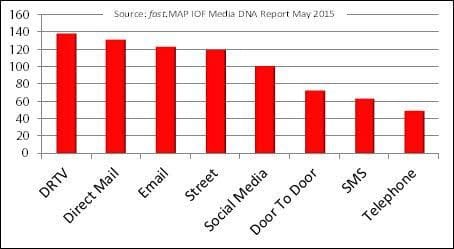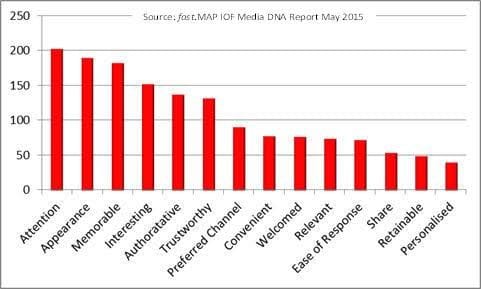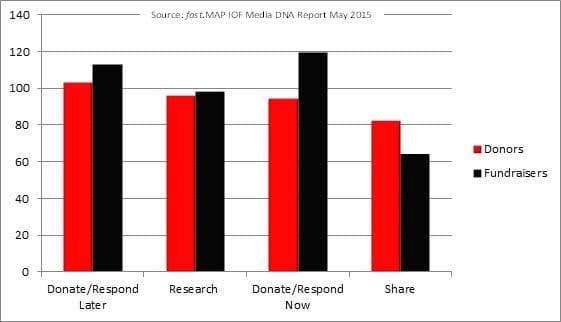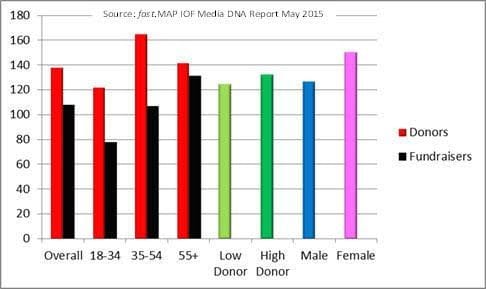DRTV: engaging, attention grabbing and for charities of all sizes

In our second analysis of fast.MAP’s Fundraising Media DNA research, carried out jointly with the Institute of Fundraising, we look at how fundraisers use direct response TV (DRTV) and how donors respond to it.
How many engage with DRTV?

DRTV is a powerful fundraising tool. According to fast.MAP’s analysis, DRTV has the highest overall engagement rate (Engagement Index; Overall, 138) of all channels. For this reason it is used to generate brand awareness as well as drive donations. No other channel matches this level of engagement: only Direct Mail (Engagement Index; Overall, 131) and Email (Engagement Index; Overall, 123) have a similar reach, engaging donors and encouraging some form of action.
Advertisement
Who engages with DRTV?
Given its high engagement score, it is not surprising that DRTV has broad appeal both to low value donors (Engagement Index ; Low Donors, 125) and high value donors (Engagement Index ; High donors, 132). Many DRTV appeals feature a low value ask, indicating the opportunity that it can lead to a higher value relationship.
While it does have broad appeal to both genders, DRTV resonates more with women than men, generating higher engagement amongst females (Engagement Index; Females, 150) than males (Engagement Index; Males, 126). This is the biggest difference between the genders across all channels.
Looking at how DRTV engagement relates to age, 35-54s are the most engaged audience (Engagement Index; 35-54, 164), more so than the 55+ (Engagement Index ; 55+, 141). Fundraisers surveyed in the research had expected this to be the other way around, thinking that DRTV engages more 55+ (Engagement Index; estimated 55+, 131) than 35-54 (Engagement Index; estimated 35-54, 107).
The most likely to engage with DRTV fundraising campaigns are 35-54s (Engagement Index; 35-54, 164) and females (Engagement Index; Females, 150). Fast.MAP suggests that campaigns targeted to this audience may see an improved response, but also acknowledges that adverts have the potential to make an impact on all target audiences.
What is DRTV’s personality?

DRTV excels at drawing attention to a message, and outperforms all the other channels examined in the analysis (Attention Index; Overall, 203). It is also seen by donors as having a strong appearance (Appearance Index; Overall, 189).
We know video campaigns can be particularly memorable; so too is DRTV (Memorable Index; Overall, 182). This could explain the high levels of later response to fundraising DRTV adverts (Donate/Respond Later Index; Overall, 103).
DRTV is a popular channel: donors seem to like it. For lower value donors, DRTV is overindexing as being the preferred way to hear from a charity (Preferred Channel Index; Low Donors, 130). In this regard it is only out-performed by email (Preferred Channel Index; Low Donors, 165) and on a par with social media (Preferred Channel Index; Low Donors, 130).
In fast.MAP’s view, this indicates that video is going continue to help support fundraising activity.
DRTV also convey a sense of gravitas across all profiles, perhaps because of the reality it tends to convey. It is seen by donors as highly authoritative (Authoritative Index; Overall, 137) and trustworthy (Trustworthy Index; Overall, 132). This suggests it can be useful in terms of brand building, as well as generating donations. This is another reason why it might prove particularly helpful for smaller charities.
According to fast.MAP, a well-made DRTV campaign, with a strong proposition and a well-planned media schedule, can be an effective way for smaller organisations to recruit supporters, overcoming any concerns about size or current brand awareness.
Perhaps one of the strengths to DRTV is that it is not seen as personalised (Personalised Index; Overall, 41). Even though good DRTV campaigns will be targeted to specific locations and demographics in terms of media buying, donors recognise and welcome the fact that it is a broad approach. On the other hand, this could perhaps explain the slightly lower engagement of 55+ (Engagement Index; 55+, 141) compared to direct mail (Engagement Index; 55+, 163).
What action do donors take when seeing DRTV?

Despite its initial impact, DRTV seems to have a latency in inspiring action. The highest response indexed for DRTV is donate/respond later (Donate/Respond Later Index; Overall, 103) suggesting DRTV activity should be repeated and reinforced across other media to help improve response rates.
55+ rate it stronger than overall in the attributes and are the most likely to donate/respond later (Donate/Respond Later Index; 55+, 111), but are not engaging as much as other demographics.
People are not notably more likely to research a charity or appeal further (Research Index; Overall, 96), even with the growth of the ‘second screen’ (the use of mobiles/tablets in parallel with television) – meaning the campaign itself needs to have a strong message.
According to fast.MAP fundraisers understand the attributes of DRTV, but misjudge the response. Optimistically they think it would lead to more immediate donations (Donate/Respond Now Index; Estimate, 119 vs. Actual 94), whereas the reality is that it mostly generates later donations (Donate/Respond Later Index; Overall, 103), suggesting use in a sustained or integrated campaign rather than as one-off drive. There can be value in repetition. Other support media, such as doordrop and outdoor, can also play a role in picking up other opportunities for the later response that the viewer intended at the time of broadcast.
As response can be later, fast.MAP and the Institute of Fundraising recommend that it is important that charity websites reflect the campaign and have an online presence that is well-designed and easy to find to support this activity.
Save the Children on DRTV
Liz McCrae, Head of Acquisition, Save the Children, said of the charity’s use of DRTV and the research findings:
“DRTV has proved to be a cost-effective way for us to engage new loyal supporters at Save the Children. With this channel we have attracted thousands of people from very different demographic groups to support our work. We have seen slightly higher response to our DRTV ads from women. This reflects the research finding that whilst it does have a broad appeal to both genders, DRTV resonates more with women than men, generating higher engagement amongst females (Engagement Index; Females 150) than males (Engagement Index; Males 126).
“With sustained DRTV campaigns we are able to refine our mix of TV stations to achieve a good return on our investment. These supporters have pro-actively donated to us either by phone or through our website. The vast majority of our DRTV recruits keep on donating for many years and they are valuable long term supporters.”
What the agencies think
Commenting on the research findings, Nick Pride, Managing Director, DMS, said:
“TV can play very different roles, perhaps the widest range of roles of any channel. At the same time it is matched only by radio in its need for single-minded simplicity if it is to be used well.
“What’s particularly interesting is that fundraisers routinely underestimate TV’s strengths. Charity supporters see TV as ‘authoritative’ and ‘trustworthy’ as well as ‘attention-grabbing’, and that view may be unaffected by the type of message contained in an individual advert. So part of DRTV’s role in a campaign is to support and reinforce the work of other channels, adding validity and ‘proof’.
“A tightly-focused proposition, with a compelling creative treatment – and of course some astute media planning – can achieve cut-through irrespective of the size of the charity; the authority of the channel is one of its key attributes.”
Scott Logie, MD, REaD Group Insight [originally linked to readgroup.co.uk], added:
“What’s interesting about DRTV is that it can work for charitable causes of all sizes. You do not need to be one of the biggest organisations to make DRTV work. By having a compelling message, with a clear call to action, you can gain new donors, providing vital funds for your cause. It is also important to still treat people as individuals, even though the channel has broad appeal. Charities need to engage the donor, showing them a clear need and how important their support can be into creating change.”
Daniel Fluskey, Head of Policy and Research, Institute of Fundraising, said:
“DRTV is an important mechanism for charities to reach a wide range of supporters in order to raise awareness of and support for their causes. Because of the nature of TV adverts it will always be hard for them to feel ‘personalised’ or to be ‘shared’, but as the research shows DRTV fundraising can do a great job of getting people’s attention and being memorable. To achieve that the content and style of the adverts must be compelling, interesting, and engaging.”
David Cole, Managing Director, fast.MAP, concluded:
“One of the most intriguing results from conducting the research was confronting the reality that people will not necessarily respond immediately to an appeal. Fundraisers overestimated the volume of people that donate immediately (Donate/Respond Now Index: Estimated 119 vs Actual 94) or donate later (Donate/Respond Later Index: Estimated 113 vs Actual 103). As a sector, we need to have a degree of realism and realise that people need to watch an advert multiple times before they are finally encouraged to act upon it. Drayton Bird, a marketer I admire and have worked with several times over the years, says people need to see something at least three times before acting. Charities need to plan their media buying accordingly to legislate for this.
“It is also interesting to note that 35-54 year olds and females are the most engaged audiences for DRTV. When marketing a mass communication, it can perhaps be tempting for organisations to water down their messaging to appeal to everyone. Perhaps giving extra weight or thought as to what appeals to this audience may also see an uplift in response and donations from the public.”
• Our first analysis of fast.MAP and the Institute of Fundraising’s Fundraising Media DNA research focused on building trust.




